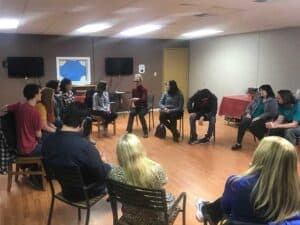Applied improvisation can help students heal from trauma, which in turn benefits their learning and relationships with their peers and adults. In this blog post, we will explore the following: the impact trauma has on students in learning environments, how teachers can aid students through trauma-informed teaching, and how that teaching can be learned through and carried out by applied improvisation.
There are several assumptions surrounding student trauma, which include but are not limited to believing a lot of students don’t suffer from trauma, a student only suffers from trauma if trauma-related behavior is apparent, and trauma-informed teaching is only helpful to students who have experienced trauma. Let’s take this piece by piece, shall we?
A lot of students don’t suffer from trauma: false. A seminal study from the Centers for Disease Control and Prevention reveals this is a misconception as the study found that “childhood trauma is far more pervasive than previously believed…” Also, a 2013 survey conducted by the National Survey of Children’s Health determined half of the nation’s children have undergone some type of trauma, which is roughly 34,825,978 children.
A student only suffers from trauma if trauma-related behavior is apparent: false (again). The same study from the Centers for Disease Prevention and Control also found that childhood trauma is not only more prevalent than we think but it “is often invisible.” Thus, trauma in students can often go completely unnoticed and even be misinterpreted as challenging behavior. This, unfortunately, can lead to little or incorrect action being taken to help these students.
Trauma-informed teaching is only helpful to students who have experienced trauma: false. Trauma-informed teaching, which includes social-emotional learning, is beneficial to all children, not just those who’ve experienced trauma. Why? Social-emotional learning practice in the classroom is foundational to building skills in self-efficacy, self-awareness, self-management, empathy, collaboration, and communication. A 2015 study outlined in the American Journal of Public Health found that “[t]he development of social-emotional skills in kindergarten leads to the higher likelihood of obtaining a college degree, adult employment, and lessens one’s chance of substance abuse or getting into trouble with the law as an adult.” Further, a 2017 study of over 97,000 K-12th graders discovered that social-emotional learning increased their academic success and continuously lowered troublesome behavior and stress.
Now that we’ve established that there is a necessary need for trauma-informed teaching, we can discuss what trauma is and its effect in learning environments. We all probably have some idea of what trauma means by our own definitions, but let’s look at its dictionary definition: “a deeply distressing or disturbing experience.” It’s important to remember that trauma is subjective in that it’s about how experiences are responded to more than the experiences themselves. There are categories of trauma which include psychological, PTSD, developmental, and others.
So how does trauma affect the learning process? In an attempt to put it simply, trauma negatively impacts the development of crucial foundational learning skills. To succeed in reading, writing, problem-solving, communicating, and being a team-player, one needs to have a solid base in the following: focus, trust, organization, comprehension, sound sense of self, memory, and emotional management. Trauma essentially can make that base a little shaky for those it affects. For example, it wouldn’t be surprising for a child to develop trust issues due to certain traumatic experiences, which would most likely affect his or her communication, collaboration, and relationship-building skills.
So what can we do as teachers? Former school leader and community college teacher Alex Shevrin Venet puts it beautifully, “Know your students.” Trauma is experienced and expressed in many different ways, which is why it is important that school communities as a whole understand the various types of trauma and how students may reveal its effect on them. This also means that teachers in the classroom must prioritize relationships. As Venet and other teachers would advise, “[S]tart by flipping the traditional classroom paradigm: Relationships have to come before content.” Now you might be thinking that it should be the other way around, and part of the issue is this misconception it should be the other way around. But what is the use of content if the students aren’t processing it correctly and learning it? Relationships are key in their building social-emotional learning skills which, as aforementioned above, increase academic excellence by supporting foundational learning skills.
Now you may be thinking, where does applied improvisation come in? Applied improvisation is all about relationships and focusing on others and the group over personal agendas. So let me ask another question: how can teachers best prioritize student relationships and “know their students”? In another attempt to put it simply, say “Yes, and.” This improv mantra requires all improvisers to accept all given offers as true (the “Yes) and supportively build off of them (the “and”). So first, let’s say “Yes” to our students. All students, especially those who’ve experienced trauma, need to feel accepted. Their traumas can be revealed in several different kinds of behaviors, both internally and externally. Thus, it is important they feel heard and validated. Then also say “and” by saying or doing something that supports their offer rather than something that negates it. This way, students don’t feel dismissed, interrupted, dominated, or shrugged off. Actively listening and communicating through “Yes, and” is a significant part in building an effective trusting relationship with all students.
What’s more is that this will encourage your students to also develop that improvisation mindset by also saying, “Yes, and.” Students who’ve been affected by trauma will more often than not say “no” to things in order to feel safe, and introducing them to “Yes, and” can help them find joy in the present moment as well as be open to saying “Yes, and” to manage daily life and unexpected uncertainties that may seem scary.
Are you or someone you know a teacher that could benefit from applied improvisation training? Or perhaps would like to incorporate applied improvisation into your classroom curriculum? Trauma-informed teaching should be a community effort. Join our community at christianafrank.com. #christianafrank
I will come directly to you as a speaker, program developer, trainer, and consultant. You have the options of choosing from a list of our personalized experts at TeamBuidlingOnPurpose as well as KidScapeProductions.com
We look forward to working with you and your students creating space and a low-risk enviornemnt to grow into a world of possibilities.
I am a certified Applied Improvisation and Applied Theatre Practitioner and Consultant who created both KidScape Productions and Team Building on Purpose. Over the last 20 years, I have been employing Applied Improvisation and Applied Theatre helping thousands of students, teachers, patients, and corporations build the best version of themselves; my passion is deeply rooted in helping people communicate effectively and feel confident with ambiguity and change. I currently sit on three educational boards in the state of Nevada, and committees for the international Applied Improvisation Network. When school is in session, my team and I support 1500 people weekly.
Consultant / Trainer/ Program Developer / Speaker
In-class day programming, after school, out of school time camps, assemblies, parties, and private coaching. 3-17 years of age.





1 thought on “Applied Improvisation and Trauma: Healing and Trauma-Informed Teaching”
Great post, Christiana. It is vital work. I have some friends who are therapists and working primarily with youth. I wonder if you or others have thoughts on how to bring this work to groups? Or maybe you have? There is so much anxiety and depression and isolation. Even some of the simplest activities could make a difference. Anyone working with youth and/or the ACES trauma. Thanks for your work and post.